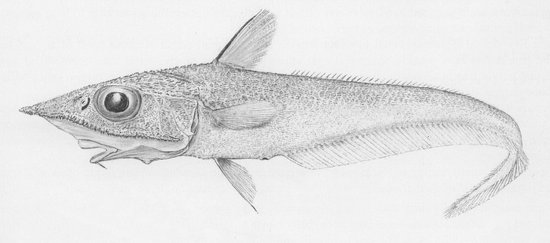- Classification
- ACTINOPTERYGII
- GADIFORMES
- MACROURIDAE
- Coelorinchus
- anatirostris
Duckbill Whiptail, Coelorinchus anatirostris Jordan & Gilbert 1904

Coelorinchus-anatirostris. Source: Coelorinchus-anatirostris. License:
Duckbill Whiptail, Coelorinchus anatirostris Jordan & Gilbert 1904
More Info
|
Distribution |
Temperate Western Pacific: known from off southern Japan to the East China Sea and off Queensland, Australia; benthopelagic on the continental slope at 300-550 m. |
|
Features |
D II 8-10; P i14-17; V 7; GR (inner) 5-8; BR 6; PC 21-30. |
|
Size |
A relatively large species reaching a length of more than 43 cm. |
|
Colour |
Overall greyish, no distinctive markings; mouth and; fins dusky to black. |
|
Feeding |
Carnivorous, feeding on small crustaceans and polychaete worms. |
|
Fisheries |
Caught as bycatch in commercial fisheries and marketed primarily as fishmeal. |
|
Conservation |
Not assessed. |
|
Species Citation |
Coelorhynchus anatirostris Jordan & Gilbert, 1904, Bull. U.S. Fish Comm. for 1902 22: 619, fig., Misaki, Japan. |
|
Author |
Bray, D.J. & G. Frankham |
Duckbill Whiptail, Coelorinchus anatirostris Jordan & Gilbert 1904
References
Bray, D.J., D.F. Hoese, J.R. Paxton & J.E. Gates. 2006. Macrouridae (pp. 581-607). In Hoese, D.F., D.J. Bray, G.R. Allen, J.R. Paxton, P.L. Beesley & A. Wells (Eds.) Zoological Catalogue of Australia. Volume 35. Fishes. CSIRO Publishing & the Australian Biological Resources Study (ABRS), 3 vols., 2248 pp.
Iwamoto, T. 1990. Family Macrouridae, pp. 90-318 In Cohen, D. M., T. Inada, T. Iwamoto & N. Scialabba (eds.) FAO Species Catalogue. Gadiform fishes of the world (order Gadiformes). An annotated and illustrated catalogue of cods, hakes, grenadiers and other gadiforms fishes known to date. FAO Fisheries Synopsis No. 125, Rome: FAO Vol. 10, 442 pp.
Iwamoto, T. 1999. Order Gadiformes. In Carpenter, K.E. & V.H. Niem. Species identification guide for fisheries purposes. The living marine resources of the western central Pacific. Batoid fishes, chimeras and bony fishes part 1 (Elopidae to Linophrynidae). FAO, Rome.
Iwamoto, T. & Merrett, N.R. 1997. Pisces Gadiformes; Taxonomy of Grenadiers of the New Caledonian region, southwest Pacific, pp. 473-570 In Crosnier, A (ed.), Résultats des Campagnes MUSORSTOM, Volume 18. Mém. Mus. Natl. Hist. Nat., 176.
Jordan, D.S. & E.C. Starks. 1904. List of fishes dredged by the steamer Albatross off the coast of Japan in the summer of 1900, with descriptions of new species and a review of the Japanese Macrouridae. Bulletin of the U. S. Fish Commission 22[1902]: 577-630, Pls. 1-8.
Merrett, N.R. & T. Iwamoto. 2000. Pisces Gadiformes: Grenadier fishes of the New Caledonian region, southwest Pacific Ocean. Taxonomy and distribution, with ecological notes. In: Crosnier, R. (ed). Résultats des Campagnes MUSORSTOM, 21. Memoires du Museum National d'Histoire Naturelle (N. S.) (Série A) Zoologie No. 184: 723-781.

